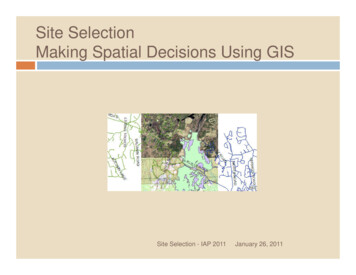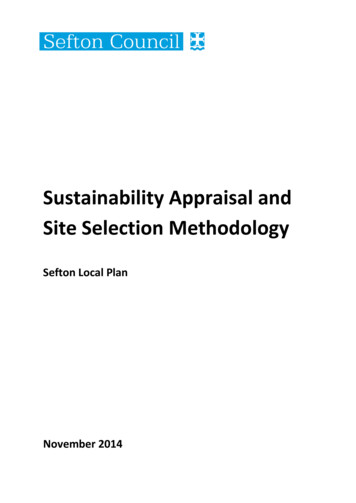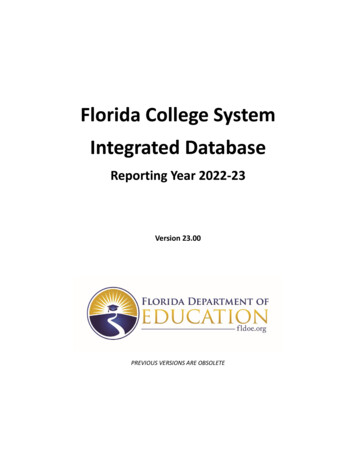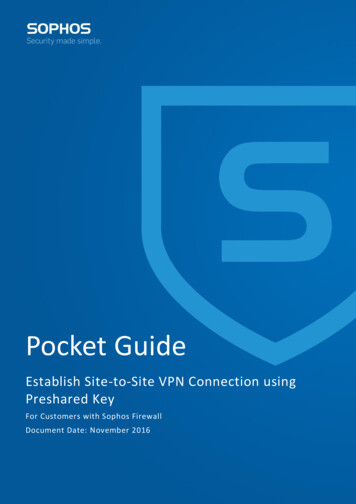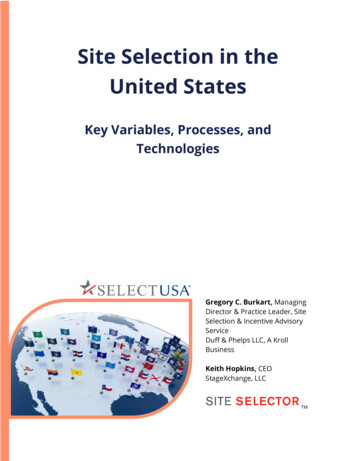
Transcription
Site Selection in theUnited StatesKey Variables, Processes, andTechnologiesGregory C. Burkart, ManagingDirector & Practice Leader, SiteSelection & Incentive AdvisoryServiceDuff & Phelps LLC, A KrollBusinessKeith Hopkins, CEOStageXchange, LLCTM
SITE SELECTIONOverview of Site Selection in the United StatesSite selection is a process of identifying a state, region, and local community to locatea new corporate facility. When investing in the United States of America, privatecompanies take responsibility for researching, analyzing, and selecting theirlocations. Different levels of government and economic development organizations mayfacilitate the corporate decision by providing the company with information, makingavailable prepared sites, fast-tracking permits, and offering cost reductions such aseconomic development incentives. 47 The decision of where and when to locate resides withthe company, its advisors, and executives.Site Selection ProcessPlanResearchModel Costs Corporatestrategy Facilitypurpose Team Public vs.private data Statevariables Summarize City variables Discountedcash flowanalysisTour Sites ChecklistPlanThe process begins with planning. When undertaking a new project, foreign investorsshould consider three items initially: corporate strategy, purpose of their facility, and advicefrom stakeholders.Corporate StrategyCompanies invest in the United States for a variety of reasons. 48 The most common reasonis accessing new markets and customers. In addition, because the shipping distances areshorter, companies find that their logistical costs are lower if they produce in the UnitedStates and ship to customers in the region, thus freeing working capital for other uses.The concept of economic development incentives are discussed in depth in SelectUSA Investor Guide, Chapter11: “Economic Development Incentives.” This chapter on site selection will incorporate incentives as part of asuggested cost model for evaluating potential locations.4748For a more thorough discussion of corporate strategy, please see SelectUSA Investor Guide, Chapter 1: “OverallInvestment Checklist.”1
SITE SELECTIONOthers find that they can improve their intellectual property and enhance their products byhiring U.S. engineers.Foreign investors typically open the following types of facilities. A sales office is usuallyopened to establish a customer base in the United States. A development and engineeringoffice permits companies to tailor their products to the needs of the U.S. market. Aftersecuring sales contracts, foreign investors typically open a warehouse or distributionfacility where they can inventory products manufactured in their home country. Because ofthe lead time associated with overseas production, investors need a place to hold theirgoods until required by the customer. Some companies choose to build manufacturingfacilities in the United States as the U.S.-based production reduces lead time for deliveringproduct to U.S. customers and frees up working capital otherwise tied up in inventory. Tomanage the various resources required to operate a manufacturing plant and serve theirgrowing customer base, foreign investors establish a facility for their corporate staff wheresales, engineering, finance, human relations, procurement, logistics, legal, and executiveleadership can work together.Facility PurposeThere are several general factors that affect selecting a state and local community. Thesefactors include workforce, logistics, real estate, business and tax climate, and utilities.i)Logistics: includes accessibility to major customers, proximity to transportationinfrastructure (such as water ports, railroads, and airports), and costs ofinbound/outbound shipping. Generally, the further a facility is from the primarytransportation node, the higher the freight costs.ii) Workforce: includes labor availability, skills, costs, and unionization.iii) Real Estate: includes availability of existing buildings, the time to obtain a certificateof occupancy, and the cost to construct improvements to an existing building or anew building on a greenfield site. Generally, the cost of construction varies widelyacross the United States.iv) Business and Tax Climate: includes operating restrictions, (such as COVID-19Executive Orders), environmental regulations, tax rates, and permits required(conditions and processing time).v) Utilities: includes available capacity, the cost of adding capacity, generation anddisposal sources, rates, and time to extend/tap.The priority of these factors usually depends on the type of facility being planned. Forexample, the most important site selection factor for distribution facilities is logistics. In thiscase, the cost of in-bound and out-bound freight will typically be the single biggest driver of2
SITE SELECTIONcompetitiveness. For manufacturing, labor availability and cost are the major drivers inselecting a site. For office operations, as the average age of the U.S. workforce is rising andnearing retirement, access to a large pool of younger workers would be critical to businesscontinuity.Team of Key StakeholdersThe last step in the planning phase is to assemble a site search team. Failing to cover all ofthe disciplines and roles on a company’s site selection team usually causes problemsduring the actual search, yielding inefficiencies as the search may have to begin afresh, orafter the project is complete, leading to operational issues and cost overruns. If there areany gaps on the internal team, a company may consider filling the gap with an outsideprofessional who is a subject matter expert in the particular field. As a best practice, thefollowing disciplines should be included on a site search team.The most critical corporate functions requiring full-time participation are:i)Human Resources: Given the importance of workforce to site searches, the humanresources department is the most knowledgeable about types of labor, requiredskills, and number of associatesrequired for a project.ii) Real Estate: The real estate team isusually tasked with aligning thephysical footprint of the companyto the business operations,analyzing the attributes of eachsite, and coordinating with brokers,engineers, and architects.iii) Operations: The operations colleagues, with experience from previous investmentprojects, are usually the most knowledgeable about timelines required to meetcustomer commitments, placement of equipment in a new facility, and laborrequired to efficiently operate such equipment. In addition, the operations team willoperate the new facility after the site is selected.iv) Supply Chain: The supply chain colleagues analyze the suppliers, assess risks, andestimate costs to bring inbound materials and transportation charges for shippingfinished products to customers.v) Finance: The finance team can help the team quantify the decision and measure itsperformance by modeling the upfront and operating costs, analyzing key siteselection variables, and assessing risks.3
SITE SELECTIONTo be successful, there are other functional areas that are required but not necessarily on afull-time basis:vi) Communications: In some states, incentives are awarded as an inducement tocreate jobs or commit investments to the location for a minimum period of time.These inducements are referred to in site selection as “but for” requirements (“butfor” the incentive, the company would not commit to creating jobs or making theinvestment in the location). A company could violate a “but for” requirement bypublicly announcing its intention to locate a project before entering into anincentives agreement with a state or community. Since the timing of anyannouncements about a project is critical to incentives, the site selection team mustcoordinate with the communications team about timing and content of anyannouncements about a project.vii) Government Relations/Public Affairs: Project success could also involve contactswith government agencies for tasks, such as expediting permits, as well asmonitoring community support for a project.viii) Legal: The legal department is usually involved in several aspects of a project,including real estate contracts, permit applications and resulting conditions,incentive agreements, legal entity formation, and qualifications to do business in anew jurisdiction.ix) Tax: The tax team is the best-suited to evaluate tax climate and estimate the taxliability, including whether there are any planning strategies that could be affectedby an incentive agreement, such as not being able to utilize non-refundable creditsdue to lack of a tax liability.When working with such a large team, it is important to establish the goals and potentialbenefits of such an investment project inorder to ensure buy-in from companyleadership and team members. Beforerecruiting colleagues to your site selectionteam, investors and/or their professionaladvisors should estimate a range ofpotential benefits. An investment such asthis is a long-term project that will requiremany people to stay motivated over thecourse of months or years.4
SITE SELECTIONResearchGoal: Narrow to a few statesAfter planning, the next step is research. While identifying variables for their site search,the site selection team should also agree upon the data to define and measure thosevariables. There is little value in using variables that do not have readily available, or costly,data sets. Once a site search team decides on its key variables and data sets, the rest ofresearch is essentially a process of elimination, using data to advance from a long list ofconsidered locations to a shorter list with narrower criteria until the search team eventuallyagrees upon a state.Data – Public versus PrivateFor data sets, there are two sources of information: public and private. Public data isgenerally collected, analyzed, and published by federal and state agencies, such as the U.S.Census Bureau, the Bureau of Labor Statistics (BLS), and the Energy InformationAdministration (EIA). SelectUSA Stats and Google Public Data Explorer each compile andaggregate a variety of U.S. and international public data resources as well. The advantageof public sources is that the information is free. The drawback, however, is the latency ofthe data: some sources have lags of 24 to 48 months.For private sources, data is available to purchase, but the databases are generally userfriendly, relatively current, and often comes with analysis and insights from the providers.There are several private data providers with information available at the state, county,and/or city level.Narrowing the Search Area to a Few StatesSelecting a group of eligible states to consider is a challenge in a country as vast and variedas the United States. An international company seeking to grow its revenue in the NorthAmerica may want to start its analysis by identifying the locations of its potentialcustomers. To identify customers, the U.S. Census Bureau maintains a database called theStatistics of U.S. Businesses, which provides data by industry sector at the state andmetropolitan statistical area (MSA) level. To estimate the size of a potential consumer base,the information is further categorized by number of establishments as well as payroll andemployees per establishment.In addition to customers, some companies may require a location that is close to theirsuppliers or critical infrastructure. For example, some companies require large amounts ofnatural gas or electricity. EIA provides publicly available maps of electric transmission linesand natural gas pipelines across the United States.5
SITE SELECTIONTo continue narrowing the search to specific states, companies should focus on a few moregeneral variables. These variables are best analyzed with independent rankings.Business climate is a large umbrella that includes several sub-factors such asenvironmental permitting requirements, state liability system, and debt as a percentage oftax revenues. One of the most comprehensive and longest running resource for BusinessClimate is “Rich State Poor State,” which is published by the American Legislative Council(ALEC). This resource publishes a score card for each state ranking their prior performanceversus the other states and forecasting their future economic outlook.Other factors may influence a location’s business climate. For example, at the time ofauthorship, an area of concern is COVID-19 state level executive orders limiting economicactivity. For current information on the COVID-19 restrictions in the United States, Krollmaintains a global heat map forecasting the impacts by country and by industry. As part ofthe heat map, there is a benchmark on the effectiveness of each state’s COVID-19 orders.Another important consideration in site selection is the tax structure for each state. It isimportant to analyze costs and burdens associated with corporate income, franchise,excise, sales/use, and property taxes. A comprehensive resource is the Tax Foundation.Each year the Tax Foundation analyzes the tax structures in each of the 50 states andpublishes a comprehensive explanation and ranking of each state’s competitiveness.Another resource available for in-depth technical information on state and local taxes is theCouncil on State Taxation.After mapping the locations for its customers and suppliers and ranking the other indices,the search team will have a range of states to look for the rest of their data points andfurther refine the search to a county or city.6
SITE SELECTIONModeling Costs: Refining the Search from States to CitiesGoal: Narrow the search to a local communityTo select a specific location from a short list of options, a discounted cash flow analysismay be most helpful as a means of directly comparing potential communities inquantifiable terms based on the company’s specific requirements.WorkforceAs discussed above, the most common variable across all types of operations is workforce.Using workforce to further refine the search has two benefits. First, with workforce databeing available at the county and city level, it is one of the most efficient ways to narrowyour search from states to a local community in each state. Second, finding enoughworkers with the right skills and the lowest cost is key to the success of many site searches.To start the analysis, the site selection team should create a staffing plan focusing on atleast three areas: worker availability, skill levels, and costs.Availability: To measure availability, a site selection team should consider several factors,such as: Population: absolute and forecasted statistics further categorized by age, race, sex,income, can be found via the U.S. Census Bureau. Employment: the numbers of workers employed by industry and by occupationincluding absolute and trending rates can be found via the Bureau of LaborStatistics (BLS). Unemployment: information by state and region is also available via BLS. Location Quotient: measuring the concentration of workers in a certain NAICScode as compared to the U.S. national average can be found via BLS. Commuting Patterns: mapping where potential employees live and their expectedtravel time to/from the anticipated facility can be found via the U.S. Census Bureau.To quantify the “availability” of a workforce in a region, a site selection team should build amodel that considers its current and future labor requirements. For such data points asretention rates and the number of students at each stage of their studies, the search teamwill need to request this information from the economic development organizations (EDOs)who represent the local communities as these data points are not publicly available. Belowis a simple model.7
SITE SELECTIONExample Workforce Analysis of a Single LocationTotal / Percentage inLocation A310,860WorkforceWorking-Age Population (Civilian Population 20 Years and Older)Current Unemployment Rate5%Full Employment Rate4%Population Available to Join Workforce3,109Total Students5,500Graduate(Master orPh.D.)1,500Undeclared1,10001,100Science, Technology, Engineering,Mathematics (STEM) FieldsArts & Science1,1003751,4751,9255632,488Business & Finance1,3755631,938Local University Students GraduatingThis YearUndergraduate(Bachelor)TotalGraduating7,000Of All Graduates in STEM, Arts & Science, or Business & Finance ProgramsHypothetical Retention Rate of LocalUniversitiesUniversity Students Expected to Join Workforce50%75%90%2,9504,4255,310Local Community College Students Graduating This YearAssociate DegreeTotal Students2,500Technical1,250Business & Finance1,250Of All Graduates in Technical or Business & Finance ProgramsHypothetical Retention Rate of Local Community Colleges60%80%95%Community College Students Expected to Join Workforce1,5002,0002,375Range of Estimates of Potential Available Workforce (Based on Possible Retention Rates)Total Available Workforce for ProjectPotential Workforce (Existing Available Workforce PlusGraduating University and Community College 99,53410,794Skills: While precise skill levels are difficult to determine without one-on-one interviews,there are a few data points that generally characterize the types of labor skills inherent in acommunity, including: Education attainment, segmented by high school, some college (which includescommunity colleges and other two-year institutions), bachelor and post-graduatedegrees, can be found via the U.S. Census Bureau. In addition to education8
SITE SELECTIONattainment, the U.S. Census also reports on school financing from state and localgovernments. Union membership and participation by occupation, industry and state is availablevia BLS, as is information regarding work stoppages.Cost: Evaluating this factor is difficult given the latency of publicly available data. Todevelop a more accurate picture of the current and future labor costs, the site selectionteam should request the data from the EDOs or, if not available, from private sources. Wages by occupation are available by industry sector and at the state, county, andcity level via BLS. BLS also provides experimental data on labor productivity. Even though it is onlyavailable at the state level for a limited number of years, this data set includesgranular details on labor productivity, number of employees, number of hours,output, real hourly labor compensation and costs, unit labor cost, and value ofproduction.Below is a simple model to compare labor costs in multiple local communities in a singlestate.State A,County WState A,County XState A,County YState A,County ZFirst Line Supervisors of Production andOperating Workers 26.88 28.20 27.92 26.93Structural Metal Fabricators and Fitters 17.02 17.74 18.27 19.47Computer Control Programmers andOperators 19.40 21.77 18.11 17.42Machine Tool Cutting Setters, Operators,and Tenders, Metal and Plastic 14.49 16.48 15.81 15.64Welding, Soldering, and Brazing Workers 17.03 17.45 17.64 19.33Critical Occupations 19.50 21.68 22.92 20.29OccupationAdditional Factors Specific to the Investment ProjectAfter analyzing the workforce in several communities in each state, a search team canbegin the process of analyzing additional factors that are more specific to the project. Tohighlight a state’s strengths and challenges, a project team should prepare a cross-statecost model. Since many of the costs and the incentives occur annually over a period ofyears, the incentives and costs should be discounted to the present value.9
SITE SELECTIONA good cost model should account for upfront costs as well as on-going operating costsand net incentives against their relevant counterparts.Upfront InvestmentsOperating CostsReal PropertyLaborLand PurchaseWages & SalarySite ImprovementsDirect LaborWalkwaysIndirect LaborParking LotsSalariedUtility Extensions andUpgradesRoads and DrivewaysUnemployment InsuranceBuildingRelocation & RecruitmentNew ConstructionPurchase Existing BuildingRenovationsAnnual Lease PaymentsLeasehold/TenantImprovementsPersonal PropertyMachinery & EquipmentPollution ControlFurniture & FixturesComputersOffice EquipmentWorkers' CompensationBenefitsUtilitiesElectricNatural GasWaterSewerTelecom / FiberTransportationInboundOutboundTaxesEconomic DevelopmentIncentivesCash GrantsTrainingRecruitingDeal ClosingJob CreationInfrastructureIn Kind ContributionsFree LandTrainingRecruitingTax Credits / ExemptionsInvestment Tax CreditsPayroll Tax CreditsProperty Tax ExemptionsSales/Use Tax ExemptionsFinancingFavorable Gross ReceiptsProperty taxReal PropertyPersonal PropertySales/Use TaxThe upfront costs usually include acquiring, constructing, and equipping a facility. If afacility will be leased, the analysis also considers leasehold improvements and/orrenovations. The responsibility to estimate the cost of a new facility in each communityusually resides with the real estate team. For land prices, the real estate colleagues obtainquotes from brokers in each community. To estimate the cost of construction in each city,the real estate members could reference private resources that compile construction data.10
SITE SELECTIONTo obtain estimates of equipping a facility, supply chain members should have thisinformation. The supply chain colleagues, through their supplier network, should be able todetermine the acquisition, shipping, and installation costs of machinery and equipment,furniture and fixtures, and computers. While the cost of the equipment may be the samefor each location, shipping and installation costs will likely vary.With respect to operating costs, analysis usually includes labor, utilities, logistics, and taxes.Labor costs are pulled from previous research using BLS Occupational EmploymentSurveys for states and metropolitan areas. In addition to wage rates, the human resourcesteam analyze incidental costs associated with workforce. For unemployment insurance, taxcolleagues can pull the rates and the salary thresholds from each state’s UI Commissionweb page. The U.S. Department of Labor’s website has a convenient map with a link toeach state’s unemployment insurance agency. For workers’ compensation, ALEC or Cerityare examples of two resources with human resource data. The real estate colleagues canobtain a quote to relocate associates from national moving firms. For relocation costs,there are several online resources, such as the Relocation Center‘s online estimation tool.For utilities, the supply chain team should have information regarding the productionrequirements for water, sewer, electricity, and natural gas, if required. For electrical rates,EIA provides rates by state and likely utility provider.To estimate logistics costs, the project team should consider transportation of rawmaterials and finished goods, as relevant. For example, for a company that plans to utilizetrucking services, several companies offer online quotes for truck loads and less than fulltruckloads on expedited and non-expedited basis, including Freight Quote and FreightCenter. For a more comprehensive decision model regarding transportation methods andcosts, there are several online software tools available, such as Llamasoft and AnyLogistix.In addition, for international investors, the project team should consider travel time andassociated costs for executives, suppliers, and customers traveling between internationaloffices and the U.S. facilities. Cities containing larger hub airports with more internationalflights may have a higher cost of living, while those containing smaller regional airportswith few or no international connections may have a lower overall cost of living. To betterunderstand the size of U.S. airports and their international connections, the FederalAviation Administration (FAA) maintains a database of the number of passengers per U.S.airport, and the Department of Transportation provides a database of international routesoffered to or from U.S. airports.When analyzing locations, the site selections team should consider state and local taxes.The model should consider corporate taxes, such as income, gross receipts and franchisetaxes, sales and use taxes, and property taxes on building, land, machinery, andequipment. These taxes can vary considerably between jurisdictions. For example, in some11
SITE SELECTIONstates, sales/use taxes are levied at both the state and local level. Moreover, some statesoffer tax exemptions for pollution control and industrial processing equipment. 49 Finally,with respect to property taxes, differences can be driven by multiplier tables, assessmentratios, and millage rates.After reviewing each section of the cost model, the site selection team sums the total costsby year, discounts the cash flows, and ranks the locations. These rankings may changewhen the project team nets the value of incentives against the relevant costs.Tour SitesGoal: Select a preferred site.With the cross-state cost model complete, a site selection team should be ready to visitlocal communities. Touring communities allows a search team to confirm the costs in itsmodel, determine a community’s interest in their project, and ascertain whether there is agood fit. In preparation for site tours, the search team should prepare a checklist so that itcan methodically evaluate the characteristics of each community and site. For a list of itemsto consider for the checklist, the U.S. General Services Administration (GSA) provides anexhaustive list that it uses for its facilities. Companies can tailor this checklist for their ownprojects.Site Selection TechnologyAdvancements in technology in recent years have truly transformed corporate siteselection. The rise of technology presents opportunities in the field of site selection fromvirtual site tours to online marketplaces to data analysis. As demonstrated in previoussections, a modern site search analyzes mountains of information on every county andmajor city in the United States.Leveraging Digital ResourcesFortunately, today there is a database for almost every conceivable location factor in theUnited States. Whether researching taxes, regulations, workforce, or wages, there is auseful database a few clicks away. Many of these resources are government funded, free tothe public, and often paired with Interactive search tools and maps that can make yoursearch more productive.49For a comprehensive discussion of state and local taxes, please see SelectUSA Investor Guide, Chapter 4: Taxes.12
SITE SELECTIONGetting StartedThe most common data resources used to begin a search often come from governmentagencies, such as BLS or the U.S. Department of Labor. Resources like the U.S. Census,state and local governmental data, and other free online resources can also be helpful.As the search for suitable locations deepens, companies will likely require a variety ofresources as they move through the process. It is important to note useful governmentresources employed when identifying potential geographic areas (such as at the state,regional, or metro area level) are rarely the same resources needed to conduct thoroughsite due diligence or to find available economic incentives.Digital ChallengesGiven the availability of so much data, it would appear that making an informed locationdecision would be easy; however, there are two practical problems most companies face.The first problem relates to how information is presented and stored during a search.Unfortunately, most resources present their data independently from any other locationfactor, thus creating a silo effect. The problem with having data organized in silos is that itbecomes difficult, if not impossible to compare different locations on the same terms.The second problem that is commonly encountered by companies with access to aseemingly endless amount of data is simply information overload. Many firms collectenormous amounts of data but then struggle to makes sense of what all the data means.Depending on the how unique the requirements for a given search are, a company couldeasily find itself needing to simultaneously evaluate dozens if not hundreds of sites acrossthe country. In fact, it is not uncommon for a search to generate over 10 gigabytes of datathat need be analyzed.One method that can be used to minimize the impact of information overload is to beginthe search looking for communities that best match the needs of the company as opposedto considering specific sites in depth too early in the process. Only after narrowing the listof communities that meet the company’s primary location decision drivers (such as laboravailability, labor costs, or average wages) should the project team begin the evaluation ofspecific sites. Finally, preparing detailed pro forma financial models for each site will allowfor accurate comparisons between sites.ConclusionWith fifty states, five territories, a federal district, and hundreds of diverse metropolitanareas, selecting new locations in the United States is best approached as a data-drivenprocess. Equally important steps include planning, researching, modeling, and touring. It iscritical to begin the site selection process with a solid understanding of why the company is13
SITE SELECTIONinvesting in the United States. Then, selecting data points and reliable sources helpsforeign investors identify a short list of states and communities to run cost models andquantify their decisions. Finally, armed with the data and cost comparisons, personallyvisiting each location permits the site selection team to assess whether a community willsupport the company and its employees for the long-term future. Communities in theUnited States have a long legacy of welcoming foreign direct investment with open arms.Dedicating time and resources to the site selection process will help a company identify thebest U.S. location for its long-term success.About Duff & Phelps and StageXchangeDuff & Phelps, LLC is a Krol
SITE SELECTION 5 Research Goal: Narrow to a few states After planning, the next step is research. While identifying variables for their site search, the site selection team should also agree upon the data to define and measure those variables. There is little value in using variables that do not have readily available, or costly, data sets.


